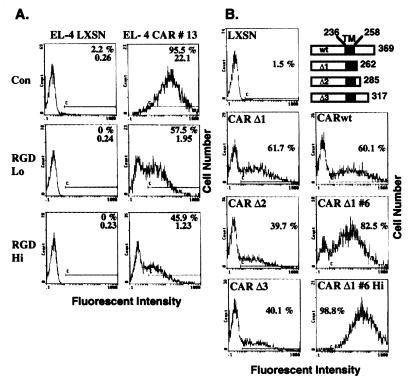Figure 3.
Adenoviral transduction is integrin dependent, but does not require the cytoplasmic domain of CAR. (A) Either EL-4 LXSN or EL-4 CAR 13 cells (105 cells per 0.1 ml in 96-well plates) were incubated for 1 hr at 37°C with 0 (Con), 0.1 (Lo), or 0.5 (Hi) mg/ml of GRGDS peptide (Sigma G4391) in 2% FBS in RPMI. AdCMV-GFP was added at an MOI of 5, and incubation continued for an additional hour at 37°C. Eight microliters of FBS then was added, and the cells were cultured at 37°C for 24 hr and analyzed on a flow cytometer. The percentage of fluorescent cells (C bar) is indicated, and the average fluorescent intensity of all of the cells is shown below the percentage. (B) Three different C-terminally truncated mutants of the hCAR receptor were generated by PCR amplification using internal primers, which resulted in a stop codon immediately following the indicated residue. The predicted transmembrane domain (TM) encompasses residues 236–258, as illustrated in the schemata (Upper Right). LXSN retroviruses encoding the CAR Δ mutants (or the LXSN and LXSN-hCAR as control viruses) were used to transduce EL-4 cells, and pooled NeoR cells were selected. The CAR Δ1 6 cell clone was derived from a single cell sorted from the highly fluorescent cells resulting from AdCMV-GFP transduction of the CAR Δ1 pool. The indicated cells were transduced with AdCMV-GFP at an MOI of either 200 (CAR Δ1 6 Hi) or 20 (all others) and analyzed by flow cytometry as described in Fig. 1. The percentage of fluorescent cells (C bar) is indicated.

